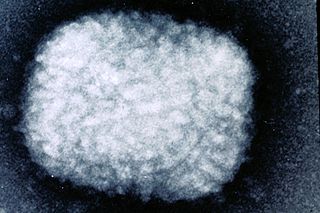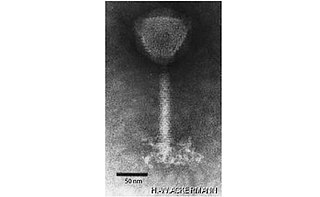Related Research Articles

Cytomegalovirus (CMV) is a genus of viruses in the order Herpesvirales, in the family Herpesviridae, in the subfamily Betaherpesvirinae. Humans and other primates serve as natural hosts. The 11 species in this genus include human betaherpesvirus 5, which is the species that infects humans. Diseases associated with HHV-5 include mononucleosis and pneumonia. In the medical literature, most mentions of CMV without further specification refer implicitly to human CMV. Human CMV is the most studied of all cytomegaloviruses.

Poxviridae is a family of double-stranded DNA viruses. Vertebrates and arthropods serve as natural hosts. There are currently 83 species in this family, divided among 22 genera, which are divided into two subfamilies. Diseases associated with this family include smallpox.

Podoviridae is a family of bacteriophage in the order Caudovirales often associated with T-7 like phages. There are 130 species in this family, assigned to 3 subfamilies and 52 genera. This family is characterized by having very short, noncontractile tails. Podoviradae are largely understudied and most new isolates are of the phicbkviruses genus, a group of giant viruses that appear to be Caulobacter specific.

Tombusviridae is a family of single-stranded positive sense RNA plant viruses. There are three subfamilies, 17 genera, and 95 species in this family. The name is derived from Tomato bushy stunt virus (TBSV).

Alphaherpesvirinae is a subfamily of viruses in the family Herpesviridae, primarily distinguished by reproducing more quickly than other subfamilies in the Herpesviridae. In animal virology the most important herpesviruses belong to the Alphaherpesvirinae. Pseudorabies virus is the causative agent of Aujeszky's disease in pigs and Bovine herpesvirus 1 is the causative agent of bovine infectious rhinotracheitis and pustular vulvovaginitis. Mammals serve as natural hosts. There are currently 45 species in this subfamily, divided among 5 genera with one species unassigned to a genus. Diseases associated with this subfamily include: HHV-1 and HHV-2: skin vesicles or mucosal ulcers, rarely encephalitis and meningitis, HHV-3: chickenpox (varicella) and shingles, GaHV-2: Marek's disease.

The International Committee on Taxonomy of Viruses (ICTV) authorizes and organizes the taxonomic classification of and the nomenclatures for viruses. The ICTV has developed a universal taxonomic scheme for viruses, and thus has the means to appropriately describe, name, and classify every virus that affects living organisms. The members of the International Committee on Taxonomy of Viruses are considered expert virologists. The ICTV was formed from and is governed by the Virology Division of the International Union of Microbiological Societies. Detailed work, such as delimiting the boundaries of species within a family, typically is performed by study groups of experts in the families.
Varicellovirus (var′i-sel′ō-vi′rŭs) is a genus of viruses belonging to subfamily Alphaherpesvirinae, a member of family Herpesviridae. Humans and other mammals serve as natural hosts. There are 19 species in this genus. Diseases associated with this genus include: HHV-3—chickenpox (varicella) and shingles; BoHV-1—infectious bovine rhinotracheitis/infectious pustular vulvovaginitis (IPV); and SuHV-1 —Aujesky's disease.

Avulavirinae is a subfamily of viruses in the family Paramyxoviridae. Members of the subfamily are collectively known as avulaviruses. All members of the subfamily primarily infect birds. Avulavirinae was previously recognized as the genus Avulavirus before being elevated to a subfamily. The term avula comes from "avian rubula", distinguishing it from rubulaviruses of the subfamily Rubulavirinae due to avulaviruses only infecting birds and translating protein V from an edited RNA transcript. The most notable avulavirus is the Newcastle disease virus, a strain of Avian orthoavulavirus 1.

Lymphocryptovirus is a genus of viruses in the order Herpesvirales, in the family Herpesviridae, in the subfamily Gammaherpesvirinae. This genus includes the human-infecting Human gammaherpesvirus 4, as well as viruses that infect both Old World monkeys and New World monkeys. Other names for the Lymphocryptovirus genus include Lymphocryptoviridae and gamma-1 herpesviruses. There are nine species in this genus. Diseases associated with this genus include: mononucleosis, Burkitt's lymphoma, and nasopharyngeal carcinoma.

The Herpesvirales is an order of dsDNA viruses with animal hosts, characterised by a common morphology consisting of an icosahedral capsid enclosed in a glycoprotein-containing lipid envelope. Common infections in humans caused by members of this order include cold sores, genital herpes, chickenpox, shingles, and glandular fever. Herpesvirales is the sole order in the class Herviviricetes, which is the sole class in the phylum Peploviricota.

Secoviridae is a family of viruses in the order Picornavirales. Plants serve as natural hosts. There are 8 genera and 86 species in this family, one of which is unassigned to a genus. The family was created in 2009 with the grouping of families Sequiviridae, now dissolved, and Comoviridae, now subfamily Comovirinae, along with the then unassigned genera Cheravirus, Sadwavirus, and Torradovirus.
Densovirinae is a subfamily of single-stranded DNA viruses in the family Parvoviridae. The subfamily has 11 recognized genera and 21 species. Densoviruses are known to infect members of insect orders Blattodea, Diptera, Hemiptera, Hymenoptera, Lepidoptera, and Orthoptera, while some viruses infect and multiply in crustaceans such as shrimp or crayfish, or sea stars from phylum Echinodermata.
Chordopoxvirinae is a subfamily of viruses in the family Poxviridae. Humans, vertebrates, and arthropods serve as natural hosts. Currently, 52 species are placed in this subfamily, divided among 18 genera. Diseases associated with this subfamily include smallpox.
Proboscivirus is a genus of viruses in the order Herpesvirales, in the family Herpesviridae, in the subfamily Betaherpesvirinae. Elephants serve as natural hosts. EEHV1 is apathogenic for African elephants but causes fatal haemorrhagic disease in Asian elephants. The name "Proboscivirus" comes from the Greek word προβοσκίς or "proboscis" meaning "the elephant trunk," for which the virus accordingly uses as its means of contraction and transmission to enter the elephant's body.
Macavirus is a genus of viruses in the order Herpesvirales, in the family Herpesviridae, in the subfamily Gammaherpesvirinae. Mammals serve as natural hosts. There are nine species in this genus. Diseases associated with this genus include: inapparent infection in their reservoir hosts, but fatal lymphoproliferative disease when they infect MCF-susceptible hosts, including cattle, deer, bison, water buffalo and pigs.
Percavirus is a genus of viruses in the order Herpesvirales, in the family Herpesviridae, in the subfamily Gammaherpesvirinae. Mammals serve as natural hosts. There are six species in this genus. Diseases associated with this genus include: conjunctivitis, immunosuppression in foals, pneumonia, respiratory disease.
Alphaabyssovirus is a genus of positive-strand RNA viruses in the order Nidovirales which infect sea hares. The genus is monotypic. It contains only the subgenus Aplyccavirus, which contains only one species, Aplysia abyssovirus 1. Alphaabyssovirus is also the only member of the subfamily Tiamatvirinae, which in turn is the only member of family Abyssoviridae, which likewise is the only member of the Abnidovirineae suborder. Aplysia abyssovirus 1 was first isolated from a sample from a California sea hare.
Alphamononivirus is a genus of enveloped, positive-strand RNA viruses in the order Nidovirales which infect planarian flatworms. Member virus planarian secretory cell nidovirus (PSCNV) has the largest known nonsegmented RNA genome of 41.1kb of any RNA virus. The genus is monotypic. It contains the subgenus Dumedivirus, which contains only one species, Planidovirus 1. Alphamononivirus is also the only member of the subfamily Mononivirinae, which in turn is the only member of family Mononiviridae, which likewise is the only member of the Monidovirineae suborder.
Ackermannviridae is a family of viruses in the order Caudovirales. Gammaproteobacteria in the phylum Pseudomonadota serve as natural hosts. There are 2 subfamilies, 10 genera, and 63 species in the family.

Herelleviridae is a family of bacterial viruses of the order Caudovirales infecting members of the phylum Firmicutes. The family has five subfamilies, 33 genera and 92 species.
References
- ↑ "ICTV Taxonomy history: Ambidensovirus". talk.ictvonline.org. International Committee on Taxonomy of Viruses. Retrieved 11 May 2020.